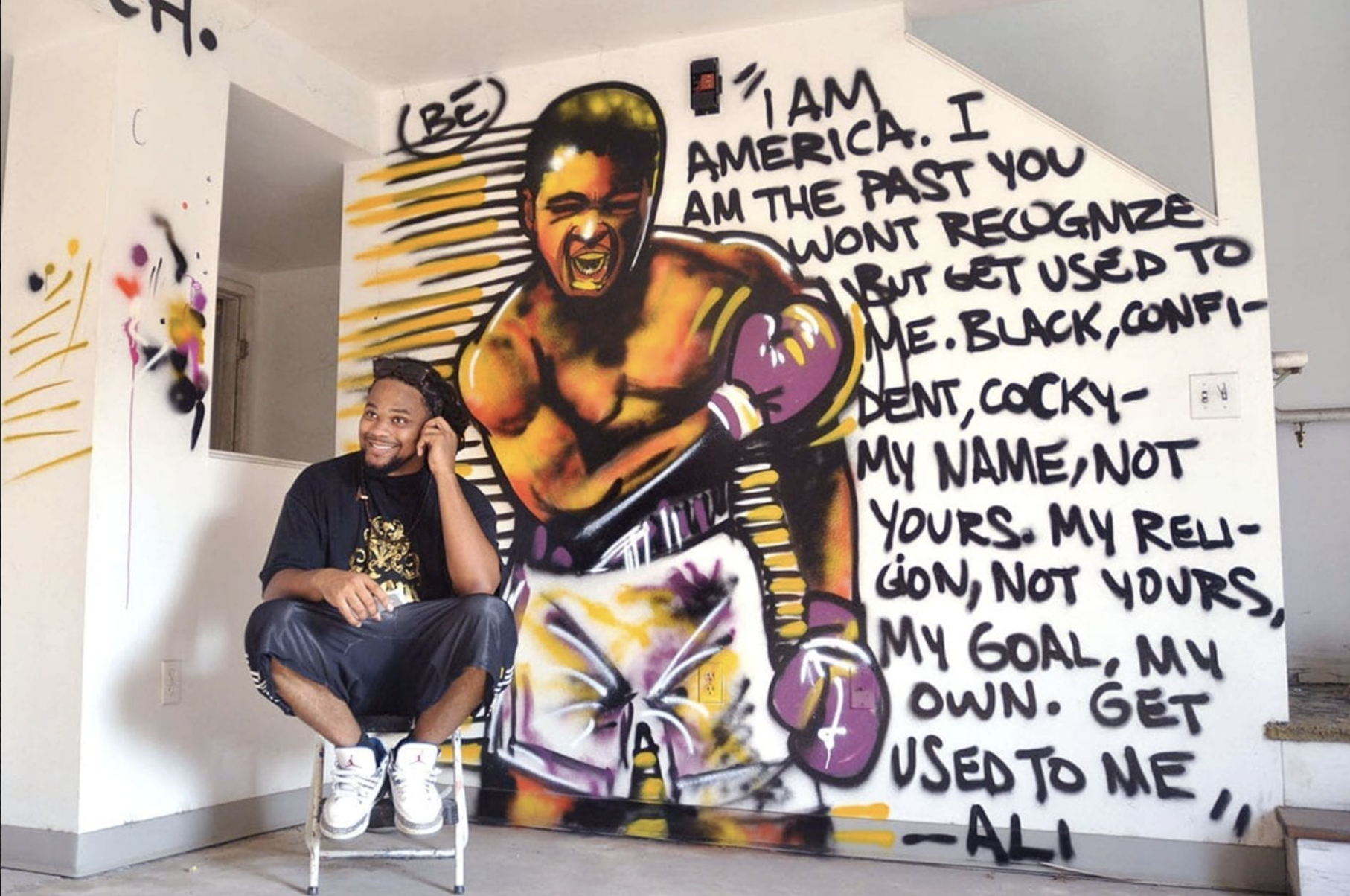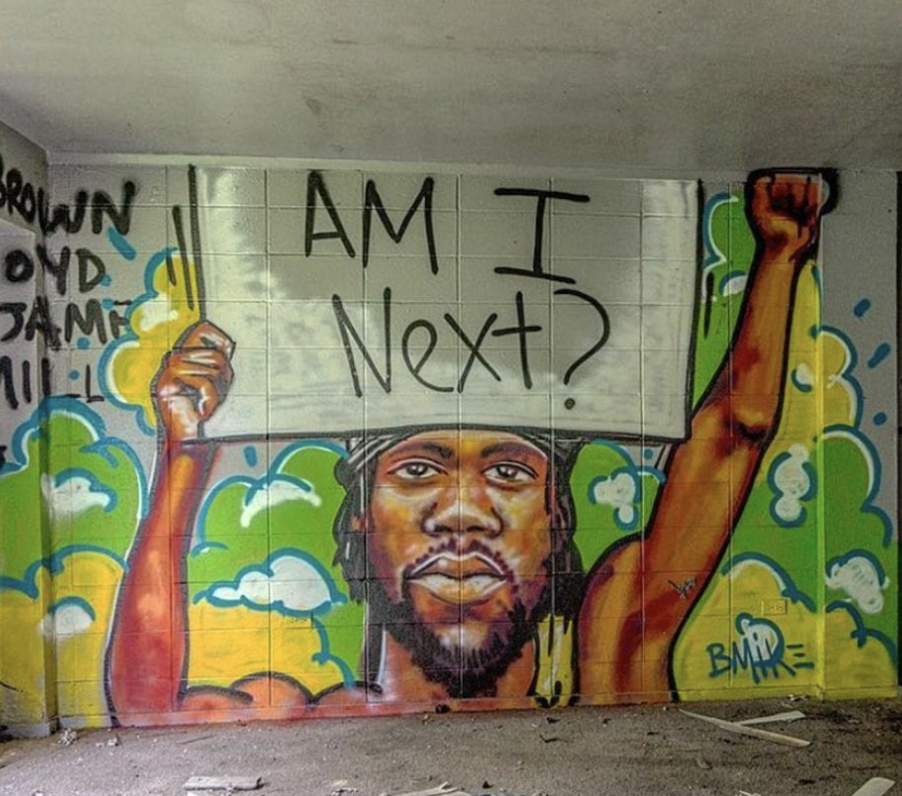By: Isabel Deutsch
With a can of spray paint in hand, Brandan Odums purposely ignored the “No Trespassing” sign while entering the rundown Florida Housing Project in the Lower Ninth Ward. The units had been abandoned since Hurricane Katrina, the walls were torn, and there was garbage and other remains scattered. Serving as a reminder of the devastation from Hurricane Katrina, Odums knew he could show the community something that would inspire them and give them something positive to look at as they passed by this project unit. And he was right. This was only the beginning of three separate studios that would vividly portray and illuminate racial injustice through massive murals.
“I am America. I am the past you won’t recognize but get used to me. Black, confident, cocky – my name, not yours. My religion, not yours. My goal, my own. Get used to me” covers half the wall, while the other half is covered by Muhammed Ali yelling in his boxing outfit, with his right hand across his chest. The size of Ali next to the quotes is large, it is overpowering, and it makes one take notice. This mural was painted in Odum’s first exhibit, Project Be.

Muhammed Ali Mural (Photo from: Bmike.com)
“Am I next?” are powerful words that are up for interpretation depending on the context they are used in. Put a sign with those words in the hands of a Black man, and the power amplifies. This mural was spray painted at Exhibit Be, Odums’ next piece on another abandoned housing project. Similarly to Project Be, this exhibit depicted additional murals that encouraged the audience to not just look at the art, but to think about it and truly experience the injustice behind them. The “Am I Next” mural invokes the feeling of frustration and injustice to anyone who comes across it, allowing visitors to feel the anger together. Many of these murals were accompanied by powerful quotes from Black men who dedicated their life to fighting racial injustice. “Almost always, the creative dedicated minority has made the world better” is part of a mural of Martin Luther King Jr. The quote and image, side by side, allow people to hear and visualize his passion.

“Am I Next” Mural (Photo by: bmike.com)
Furthermore, visitors would go up to Odums to share their personal stories and experiences that they wanted to be heard. The artists not only listened to these stories, but they translated them into murals. Also, children were given art supplies to “leave their truth” at Exhibit Be, drawing what they were passionate about. Whether it be painting old tires left on the ground or something on the concrete, these children were able to say to their parents, “come check out my work!”
January 19th, 2015, Martin Luther King Jr. Day and the last day of Exhibit Be, would be iconic in the New Orleans community. Not only did the murals represent Black figures, famous or not, with powerful messages depicted implicitly or explicitly, but having closing day on this day underscores the commitment and importance of addressing racial injustice.
A police officer holding a gun, with “fear” written all over it, is pointed towards a young Black woman. She is holding the stem of a red flower in the barrel and has “love” written throughout her hair. Another of a Black man in between two white police officers, one with a smirk and a weapon in hand, while the Black man visually fears for his life. These murals are seen in Odum’s current 36,000-square-foot gallery, Studio Be. His feelings toward police brutality are expressed in these powerful art pieces, allowing the community to feel the frustration and anger with him. Not only does this art form enable self expression, but these studios have allowed all people to either identify with or experience it in their way.

Police Officer x Young Woman Mural (photo from: bmike.com)
Murals are an interactive way for audiences to feel what the artist wants, as are jokes from stand-up comedians. “37 percent of unarmed people killed by police last year were Black, even though Blacks only make up 13 percent of the US population”, followed by “oof,” is Phoebe Robinson’s way of talking about police brutality. It contains the same enraged message as Odum’s, but with a different execution, using humor to elicit a response. Robinson, a comedian, author, and actress, shares her personal stories in the book You Can’t Touch My Hair: And Other Things I Still Have To Explain, using a comedic approach to discourse surrounding racial injustice.
As Phoebe Robinson prepared to step onto the stage to perform her comedy act, she was anxiously eating in the green room, watching the reactions of the other participants as they walked off stage. Before she knew it, in her new outfit, she went on stage eager to impress the judges and the audience with her 4 minutes of jokes. She had “rushed a couple of punch lines and perhaps challenged the audience” with her “race material.” While that is objectively an accomplishment, using humor to talk about race issues, the female judge responded, “You know, you come off as the smartest person in the room. You should watch that, so you’ll be more likable.” In writing about this story, Robinson used her sarcastic and witty humor to address this sexist comment to her readers with an “I’m sorry, but eeeeeeeww.” Her remarks regarding this personal situation that most definitely impacted her life allow the audience to feel “ew’d” out with her, and understand the main issue with that comment.
Through her book, “You Can’t Touch My Hair: and Other Things I Still Have to Explain” Robinson has made it clear that the stereotype of an “angry Black woman” forces her to be extra cautious while responding to certain remarks, no matter how rightfully so angry should feel. While walking onto the stage, a white comic introduced her by saying, “Do you guys like pussy? Well this next person has one.” Rightfully enraged at this completely inappropriate comment, Robinson writes about how she politely explained to him that the comment was inappropriate and unacceptable. The response from the white man was: “WHOA! Calm down. Don’t need to get all angry Black woman on me. But that wouldn’t be the first time that happened to me.” The art that Robinson has mastered allows these pervasive issues to be expressed in ways that make the audience feel her frustration by writing about her opinion and reaction to them in more of a lighthearted way: “UGH! This sort of thing happens all. the. time.”
 NOLAbeings
Multimedia artist Claire Bangser created NOLAbeings as a portrait-based story project that marries...
NOLAbeings
Multimedia artist Claire Bangser created NOLAbeings as a portrait-based story project that marries...
 Data corner: Adobe Suite (create a PDF, social media graphic, presentation, edit a photo and video
Data corner is where you go to work with analytics and top tech skills. It takes on everything from PERL and SQL to Canva and Sprout Social.
Data corner: Adobe Suite (create a PDF, social media graphic, presentation, edit a photo and video
Data corner is where you go to work with analytics and top tech skills. It takes on everything from PERL and SQL to Canva and Sprout Social.
